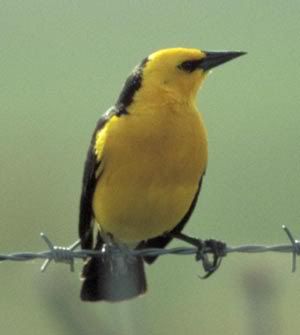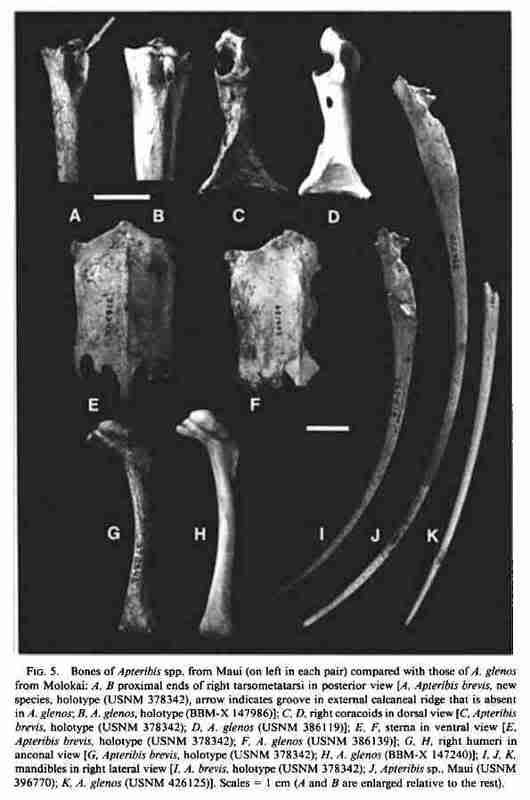Post by sebastian on Oct 24, 2006 2:38:18 GMT
Apteribis glenos Olson and Wetmore, 1976
(Fig. 5B, D, F, H, K)
Apteribis glenos Olson and Wetmore, 1976:252; Olson and James, 1982b:33; 1984:771.
Holotype: Complete right tarsometatarsus, BBM-X 147986 (Fig. 5B).
Type locality: Site 6, Moomomi dunes, Molokai, Hawaiian Islands.
Distribution: Molokai: Moomomi and Ilio Point dunes, and Kalaupapa Peninsula.
Emended diagnosis: See diagnosis of Apteribis brevis.
Material: In addition to the holotype and paratypes, the followgin specimens of A. glenos were examined: tip of premaxilla, USNM 426124; mandibular symphysis, USNM 426125 (Fig. 5K); mandible lacking left articulation and distal portion of symphysis, USNM 386135; incomplete sternum USNM 386139 (Fig. 5F); right coracoid, USNM 386119 (Fig. 5D); left humerus, USNM 386120; left ulnae, USNM 386121, BBM-X 152462.
Remarks:O lson and Wetmore (1976) described the fossil remains of a flightless ibis from Molokai as Apteribis glenos, a new genus and species, designating a tarsometatarsus from the Moomomi dunes as the holotype. A long with paratypes from Molokai, they also included the largely fragmentary remains of a single individual from the Lower Waihoi Valley Cave on Maui, which at the time was the only specimen of ibis known from that island.
Hundreds of bones of Apteribis have since been collected on Maui, whereas collecting on Molokai has been less productive, so that sample sizes from Maui are now much greater. Several qualitative characters distinguish the sample of Apteribis from Molokai from all individuals collected on Maui, so that recognition of at least one additional species is warranted. The geographic range of A. glenos
may now be restricted to the island of Molokai.
Based on our analysis of size variation, there appear to have been two altitudinally separated populations (species) of Apteribis on Maul. If a second species in addition to A. glenos also occurred at higher elevations on Molokai, we would not have collected it because all fossil sites found so far on Molokai are near sea level.
(Fig. 5B, D, F, H, K)
Apteribis glenos Olson and Wetmore, 1976:252; Olson and James, 1982b:33; 1984:771.
Holotype: Complete right tarsometatarsus, BBM-X 147986 (Fig. 5B).
Type locality: Site 6, Moomomi dunes, Molokai, Hawaiian Islands.
Distribution: Molokai: Moomomi and Ilio Point dunes, and Kalaupapa Peninsula.
Emended diagnosis: See diagnosis of Apteribis brevis.
Material: In addition to the holotype and paratypes, the followgin specimens of A. glenos were examined: tip of premaxilla, USNM 426124; mandibular symphysis, USNM 426125 (Fig. 5K); mandible lacking left articulation and distal portion of symphysis, USNM 386135; incomplete sternum USNM 386139 (Fig. 5F); right coracoid, USNM 386119 (Fig. 5D); left humerus, USNM 386120; left ulnae, USNM 386121, BBM-X 152462.
Remarks:O lson and Wetmore (1976) described the fossil remains of a flightless ibis from Molokai as Apteribis glenos, a new genus and species, designating a tarsometatarsus from the Moomomi dunes as the holotype. A long with paratypes from Molokai, they also included the largely fragmentary remains of a single individual from the Lower Waihoi Valley Cave on Maui, which at the time was the only specimen of ibis known from that island.
Hundreds of bones of Apteribis have since been collected on Maui, whereas collecting on Molokai has been less productive, so that sample sizes from Maui are now much greater. Several qualitative characters distinguish the sample of Apteribis from Molokai from all individuals collected on Maui, so that recognition of at least one additional species is warranted. The geographic range of A. glenos
may now be restricted to the island of Molokai.
Based on our analysis of size variation, there appear to have been two altitudinally separated populations (species) of Apteribis on Maul. If a second species in addition to A. glenos also occurred at higher elevations on Molokai, we would not have collected it because all fossil sites found so far on Molokai are near sea level.






